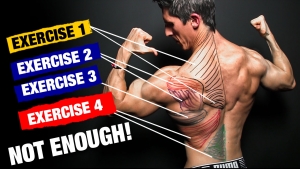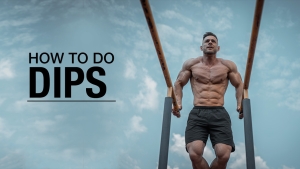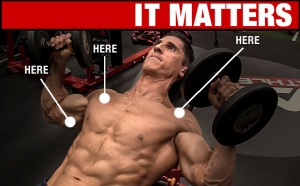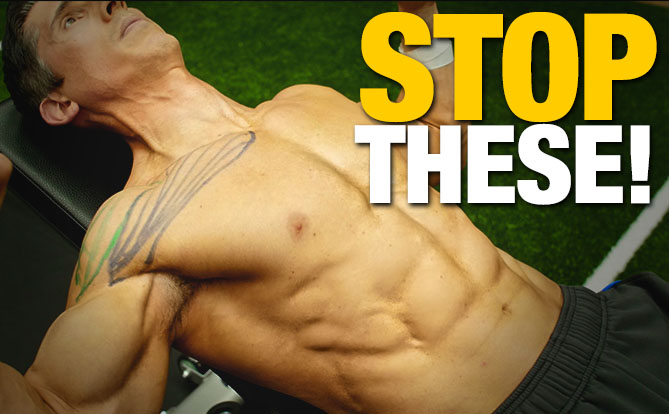
THE PROBLEM WITH THE INCLINE BENCH PRESS
The Incline Bench Press exercise variation is one of the best upper chest exercises there is, but there’s one major problem preventing us from getting the maximum benefit out of it.
The front delt likes to dominate the movement, taking away from the action of the upper chest as the primary muscle!
You see, these two muscles – the anterior deltoids and the upper chest fibers of the pectoralis major – are really close to each other, which means that one of the two can really start dominating the other if we don’t do this dumbbell chest exercise correctly.
The front deltoid gets a great deal of work from not just shoulder workouts and exercises, but as an assistant on many pushing and common chest exercises as well as any every day activities that we do in the front of our body. This causes the front delt to become almost too active, especially during exercises that we are trying to stress the upper chest like the Incline Bench Press.
There are two big mistakes that most people make with the dumbbell Incline Bench Press that are making this situation worse!
If you’re making either of these two errors, it’s preventing you from maximizing your upper body workout.
I’m going to show you the two worst Incline Bench Chest Press mistakes…and I’m going to be breaking out the Muscle Markers to help you get more out of this intense exercise!
First, so we have a better understanding of this popular movement, let’s take a look at what target muscles the dumbbell incline bench press works.
INCLINE BENCH PRESS MUSCLES WORKED
- Front Delt
- Clavicular Head (Pectoralis Major)
The main muscles worked during incline presses are the front deltoid and the clavicular head (upper portion of pectoralis major). However, in order to get the muscular activation in the upper pecs in this incline chest press exercise, it’s crucial to get the bench angle correct.
Since we’re trying to use the dumbbell incline bench press to hit the upper portion of the pec major, we want to minimize the activation of the shoulder musculature. Read on to see what the correct incline bench press angle is, and why.
And to ensure you get strong mind muscle connections, take a look at the anatomy below so that you can see where the front delt and the pec major are located.
MISTAKE #1: USING THE WRONG BENCH ANGLE
In order to get the front shoulder to do less of the work and allow the pecs to do more, you have to first get the angle of the dumbbell incline bench press correct when you do this simple movement.
So, what is the angle that you want to use on the incline dumbbell bench press exercise in order to hit the upper chest as the prominent muscle? An Upright Shoulder Press is going to maximize the attention that front delts get because the arms move in a straight line up against gravity in an overhead pressing motion.


If I were to back off the angle of the Upright Shoulder Press and set the incline bench press angle to 60 degrees – which is one of the most common angles that people will do incline presses – then you’re going to position your body to shift the focus down a little bit.
But you can see this is a larger muscle and it’s not enough to put the focus down through the mid-belly of the upper chest.
So setting the flat bench to 60 degrees is a bench angle mistake. It’s not a low enough incline bench setting and you might want to go a bit lower.

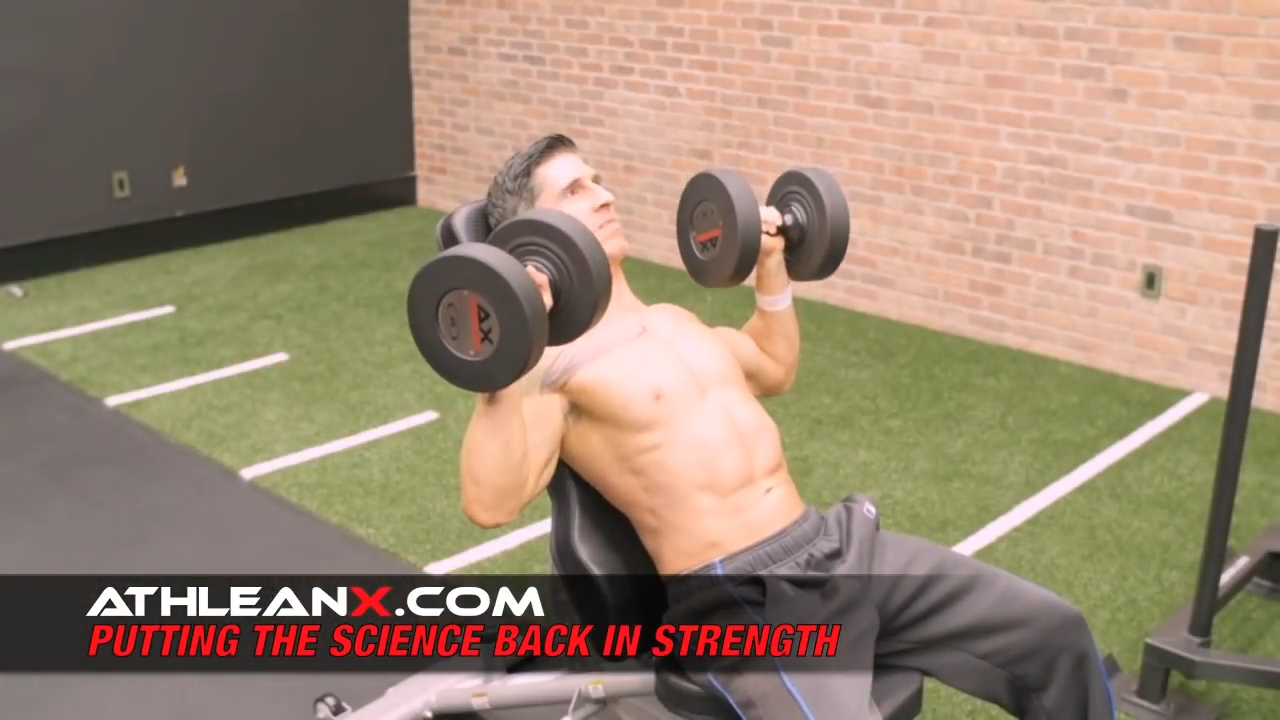
Here we’re setting our adjustable benches down to a 45degree angle, and that’s somewhat better for this dumbbell press.
Anytime you start going lower, you’re shifting that focus down, but at 45 degrees you’re still not really there.


CORRECT INCLINE BENCH PRESS ANGLE
What is the best incline bench press angle for hitting the upper chest?
Research shows that the correct angle of the Incline DB Bench Press should be 30 degrees from flat to target the upper chest for muscle growth.
30 degrees may seem like a very small angle, but it is proper incline bench press form for placing the strain on your upper pecs and minimizing the effect on the anterior deltoid muscles.
Many people will stay much too upright in the starting position when performing this chest exercise, and effectively wind up hitting their shoulder muscles too much.
If you realize that a completely vertical bench position (90 degrees elevated) would primarily achieve shoulder activation, and that a completely flat bench version at 0 degrees (Flat Dumbbell Bench Press, Regular Bench Press or Traditional Bench Press) would hit your middle chest (because your arms are at a 90-degree angle to your body), you understand that you’ll need to lower the bench quite a bit to get upper chest engagement.

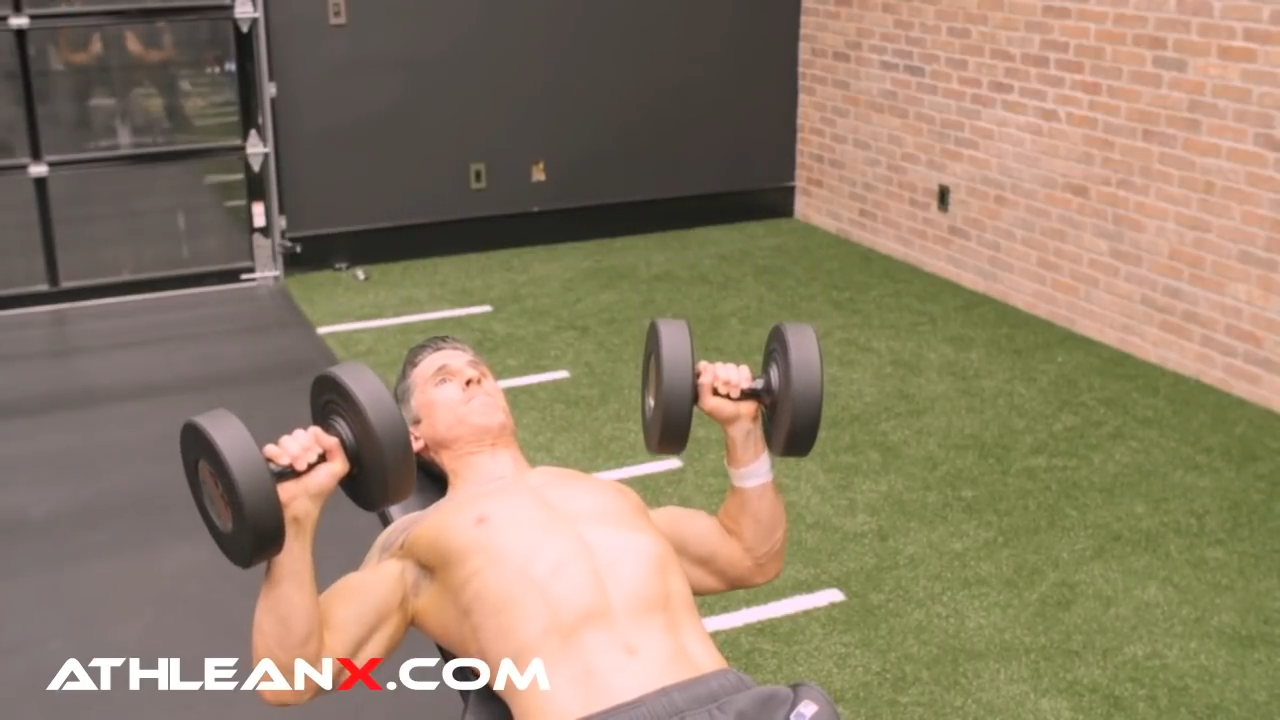
MISTAKE #2: NOT SQUEEZING THE SHOULDER BLADES
As you’ve seen me bang out a couple reps of the dumbbell variation of the Inclined Bench Presses at 30 degrees, notice the position of my shoulder.
When the front delt becomes dominant, our shoulders tend to round forward. A lot of people reading this are probably sitting there right now with shoulders rounded forward.
That’s common, unfortunately.
What happens is, the front delt is actually put in more of a position of power in relation to the chest. It’s actually standing out more, willing and able to push more and spring to action more quickly than your upper chest.
We can silence that by getting it back where it belongs, allowing the chest to now be in a better position to contract. The way to do that is through positioning our shoulders in the right direction.
We want to make sure that whenever we press upward, we contract the shoulder blades back and down.
This back and down position places your shoulder blades backward in a position where they can be less dominant in the Incline Dumbbell Bench Press and put your pecs at the center of the action.

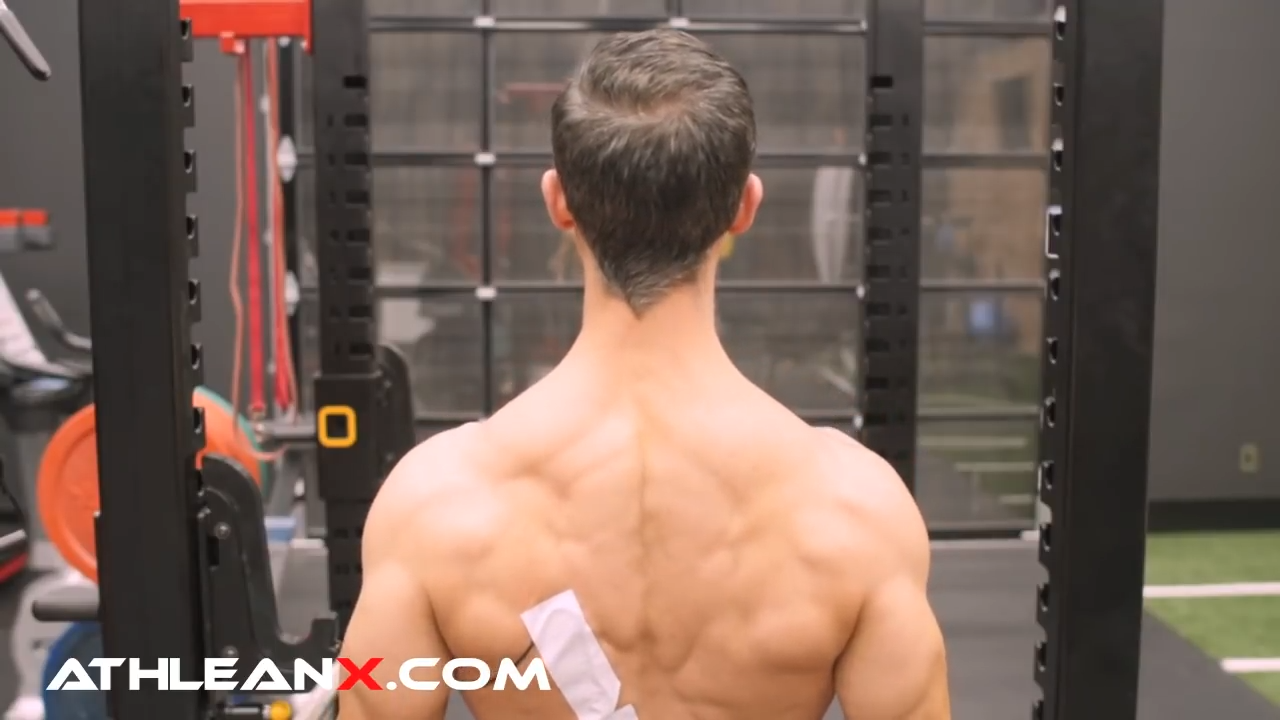
HOW TO DO INCLINE BENCH PRESS CORRECTLY
With the 30 degree angle on the bench, gravity helps to position the shoulder blades back and down, but you can’t just rely on the fact that the bench is helping you get there.
You do need to actively contract your shoulder blades as well to ensure that this happens. Squeezing the shoulder blades makes it much easier for the chest to be in a position of power and therefore increase their contribution to the dumbbell Incline Bench Press. This, over a period of time, will lead to greater chest muscle growth particularly in the upper chest.


HOW TO DO THE INCLINE BENCH PRESS
- Set the angle of the incline workout bench to 30 degrees.
- Grab a pair of dumbbells and position yourself in the bench with feet flat on the ground.
- Actively contract your shoulder blades back and down as you press the weight away from your chest to a full range of motion, using a mind to muscle connection to focus on the upper pecs.
- Lower the dumbbells with control to the starting position and repeat.
I hope you’ve found these exercise guides for the dumbbell Incline Bench Press to be helpful. Remember, this is about putting the science back in strength training. When it comes to strength and muscle building I don’t like to just tell you which are the best exercises to do but instead WHY they’re good and how to get the most out of them so you can get better results faster when you follow our training.
You can see how making even the smallest mistakes in your training can cause lost results and lost time. If you’re looking for a complete training plan that puts the science back in strength and muscle growth, helps you avoid common mistakes and gives you workout tips to get the most out of every single exercise you do, check out our ATHLEAN-X strength programs. See how training like an athlete with the best training tips and exercises can help you lose fat and build strength, power and muscle mass throughout your entire body.

- Because the front delt and the upper chest muscles are so close together, the front delt has a tendency to dominate in the Incline Dumbbell Chest Press. Many people don’t know how to incline bench press with proper form, and there are two common mistakes that make this front deltoid dominance more pronounced and two workout tips I’ve given to correct them.
- Mistake #1: Using the wrong bench angle exacerbates this problem. Research shows that performing an incline chest press with a 30 degree bench angle is the best for the upper chest.
- Mistake #2: Not engaging the shoulder blades in your incline presses also makes shoulders round forward which allows the front delt to be dominant. Making an intentional down and back movement of the shoulder blades helps the upper chest to be in a better position to contract.
INCLINE BENCH PRESS FAQS
Some people find that the incline bench press is harder than flat bench presses because the front delt likes to dominate the movement and tends to take away from the action of the upper chest because of how close in proximity these two muscles are. We're trying to hit the upper chest, not do another compound shoulder exercise, so it's important to get the bench angle right. To make the incline bench press favor the upper chest portion of the pectoralis major more, be sure to use the correct bench angle of 30 degrees and squeeze the shoulder blades. However if you want to build a stronger chest, it's important to use effective exercises to target the middle and lower portions of the pectoral muscle as well. To do this, move from an inclined position to a neutral position on the adjustable bench to hit the middle pecs, and use a declined position to hit the lower pecs.
Research shows that the correct angle of the Incline Barbell Bench Press should be 30 degrees from flat to target achieve the best muscular activation in the upper chest. This is one of the best incline bench exercises for upper chest activation, and one that you should definitely focus in each chest day workout.
Incline bench press training is one of the best upper chest exercises for chest strength and muscle mass, but for this bench press variation you need to ensure that you're not allowing your front delts to dominate the movement. To avoid this, be sure to use the correct bench angle and squeeze your shoulder blades during the movement. The incline bench press will preferably hit the upper chest whereas the flat barbell bench press hits the mid-pecs. Done correctly, incline bench press benefits are that it's excellent for targeting the upper pec muscles and helps prevent muscle imbalances (one-sided muscle weaknesses) when performed with dumbbells, because it is a unilateral exercise.
Some people ask whether a 30 to 45-degree bench position is better for upper pec activation in an incline bench press. Research shows that the correct angle of the Incline Barbell Bench Press should be 30 degrees from flat to target maximum upper chest muscle activation during bench press. Adjustable training benches allow you to change the angle of bench incline so that you can achieve the best possible activation of the upper chest muscle fibers.
To do the incline bench press variation, the bench presser should set the incline bench angle on the bench press station to 30 degrees. Sit on the adjustable weight bench and lean against the backrest, taking a pair of dumbbells in each hand. Press straight outward in front of your chest, squeezing the shoulder blades to avoid the front delts taking over the movement. 30 degrees is the best inclined position to help you to achieve the best upper pectoralis activation. Starting weight for this chest press variation should be with a lighter weight instead of heavy weight for strength gains. As you get stronger in this popular exercise, you can increase your rep range and your sets over time. Once you are doing about 3 sets of 10-12 reps with ease, you can move to heavier weight over time for muscle hypertrophy. Done correctly, dumbbell incline bench presses are one of the best exercises for upper body strength gains and muscle growth, and preventing strength imbalances (differences in strength from one side of the pecs to the other).
The incline bench press is one of the best upper chest exercises, but you need to ensure that you're not allowing your front delts to dominate the movement. To avoid this, be sure to use the correct bench angle and squeeze your shoulder blades during the movement. In order to build strong chest muscles, you should be sure to include exercises that activate upper, mid and lower pecs in your workout routine. To focus on the entire chest musculature, you can use exercises like decline bench presses to hit the lower pecs and a standard bench press to hit the mid pecs by setting the bench to flat bench position.
To achieve the best activation of the upper pectoral muscles and for maximum strength gains and muscle growth, the best incline angle for the barbell incline bench press is 30 degrees from horizontal bench position which you can do on an adjustable type of bench.
Some people want to know if 30 or 45-degree incline bench position is best to hit the upper chest. To achieve the best upper pec activation, 30 degrees is a more optimal angle than a 45-degree angle for the incline bench press. In this incline position, you will be favoring the upper portion of the pec major, making this a very effective exercise for upper chest.
The best incline bench press angle for strength gains and muscle growth in the upper chest is 30 degrees. While some lifters make the mistake of adjusting to a 15 or 45-degree angle, research shows that the influence of bench angle on the upper pecs is greatest at a 30 degree position.
REFERENCES

Jeff Cavaliere M.S.P.T, CSCS
Jeff Cavaliere is a Physical Therapist, Strength Coach and creator of the ATHLEAN-X Training Programs and ATHLEAN-Rx Supplements. He has a Masters in Physical Therapy (MSPT) and has worked as Head Physical Therapist for the New York Mets, as well as training many elite professional athletes in Major League Baseball, NFL, MMA and professional wrestling. His programs produce “next level” achievements in muscle size, strength and performance for professional athletes and anyone looking to build a muscular athletic physique.
















